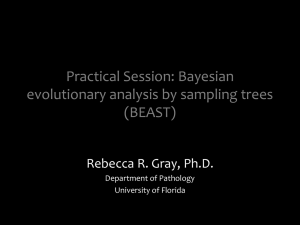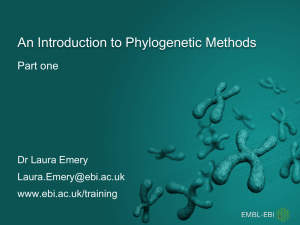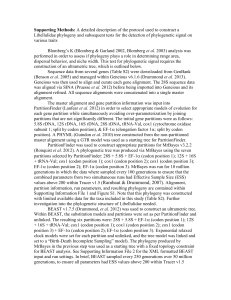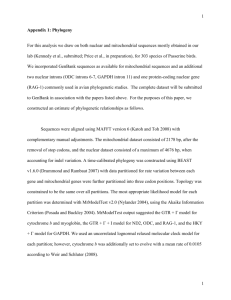jbi12253-sup-0002-AppendixS2-FINAL
advertisement
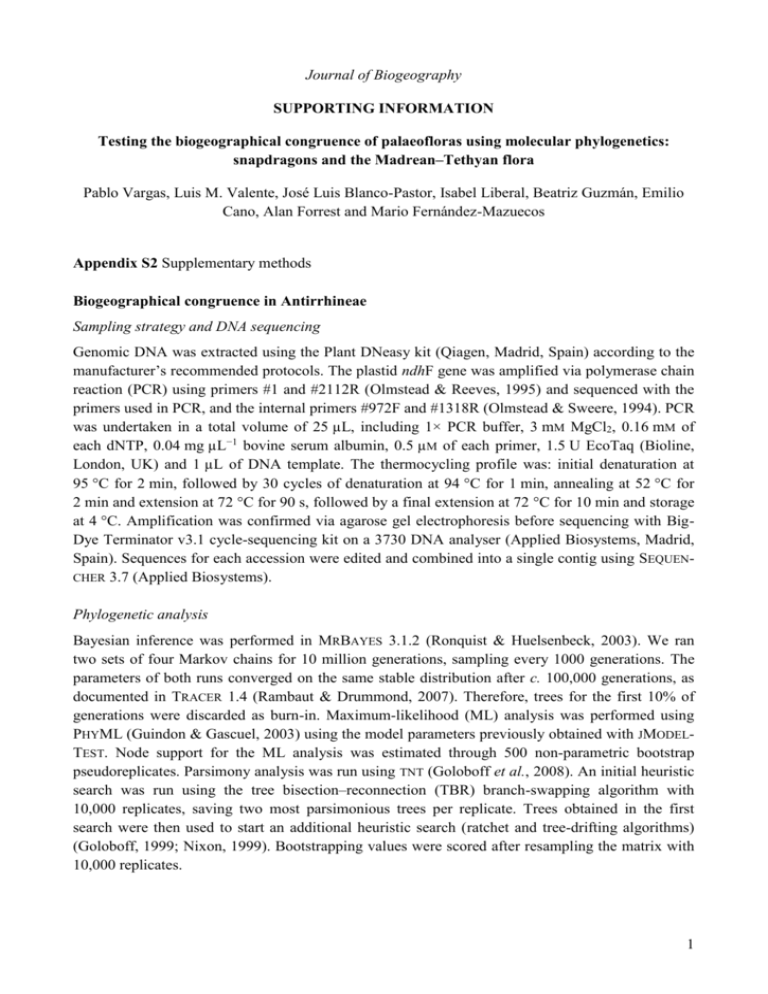
Journal of Biogeography SUPPORTING INFORMATION Testing the biogeographical congruence of palaeofloras using molecular phylogenetics: snapdragons and the Madrean–Tethyan flora Pablo Vargas, Luis M. Valente, José Luis Blanco-Pastor, Isabel Liberal, Beatriz Guzmán, Emilio Cano, Alan Forrest and Mario Fernández-Mazuecos Appendix S2 Supplementary methods Biogeographical congruence in Antirrhineae Sampling strategy and DNA sequencing Genomic DNA was extracted using the Plant DNeasy kit (Qiagen, Madrid, Spain) according to the manufacturer’s recommended protocols. The plastid ndhF gene was amplified via polymerase chain reaction (PCR) using primers #1 and #2112R (Olmstead & Reeves, 1995) and sequenced with the primers used in PCR, and the internal primers #972F and #1318R (Olmstead & Sweere, 1994). PCR was undertaken in a total volume of 25 µL, including 1× PCR buffer, 3 mM MgCl2, 0.16 mM of each dNTP, 0.04 mg µL−1 bovine serum albumin, 0.5 µM of each primer, 1.5 U EcoTaq (Bioline, London, UK) and 1 µL of DNA template. The thermocycling profile was: initial denaturation at 95 °C for 2 min, followed by 30 cycles of denaturation at 94 °C for 1 min, annealing at 52 °C for 2 min and extension at 72 °C for 90 s, followed by a final extension at 72 °C for 10 min and storage at 4 °C. Amplification was confirmed via agarose gel electrophoresis before sequencing with BigDye Terminator v3.1 cycle-sequencing kit on a 3730 DNA analyser (Applied Biosystems, Madrid, Spain). Sequences for each accession were edited and combined into a single contig using SEQUENCHER 3.7 (Applied Biosystems). Phylogenetic analysis Bayesian inference was performed in MRBAYES 3.1.2 (Ronquist & Huelsenbeck, 2003). We ran two sets of four Markov chains for 10 million generations, sampling every 1000 generations. The parameters of both runs converged on the same stable distribution after c. 100,000 generations, as documented in TRACER 1.4 (Rambaut & Drummond, 2007). Therefore, trees for the first 10% of generations were discarded as burn-in. Maximum-likelihood (ML) analysis was performed using PHYML (Guindon & Gascuel, 2003) using the model parameters previously obtained with JMODELTEST. Node support for the ML analysis was estimated through 500 non-parametric bootstrap pseudoreplicates. Parsimony analysis was run using TNT (Goloboff et al., 2008). An initial heuristic search was run using the tree bisection–reconnection (TBR) branch-swapping algorithm with 10,000 replicates, saving two most parsimonious trees per replicate. Trees obtained in the first search were then used to start an additional heuristic search (ratchet and tree-drifting algorithms) (Goloboff, 1999; Nixon, 1999). Bootstrapping values were scored after resampling the matrix with 10,000 replicates. 1 Bayesian dating The basal divergence between Oleaceae and Antirrhineae was modelled as a normal distribution with mean 74 Ma and standard deviation 2.5 Myr, on the basis of an estimate obtained in the most recent relaxed-clock analysis of angiosperms (Bell et al., 2010). Five minimum stem-age constraints for Lamiales families and tribes were based on five fossils (Table 1). Fossil calibrations were placed at the stem nodes of clades, or the basal nodes of taxa, to which fossils are unambiguously assigned. Clades were constrained as monophyletic based on phylogenetic results. Fossil calibrations were modelled as lognormal distributions with mean 0, standard deviation 1 and offset values corresponding to the upper limit of the time interval to which fossils are assigned (Table 1). The substitution rate variation was modelled using an uncorrelated lognormal distribution, and a birth– death process (Gernhard, 2008) was employed as tree prior. Four Markov chain Monte Carlo analyses were run for 20 million generations each, with a sample frequency of 1000. Chain convergence was examined in TRACER 1.4 (Rambaut & Drummond, 2007) by inspection of trace plots and effective sample sizes (ESS). The four chains were combined in LOGCOMBINER 1.4.8 after discarding the first 10% of sampled generations as burn-in. Trees were summarized in a maximum clade credibility tree obtained in TREEANNOTATOR 1.4.8 and visualized in FIGTREE 1.3.1 (Rambaut, 2009). Testing the Madrean–Tethyan hypothesis across angiosperm groups Once the monophyly of the ingroup was tested, analyses of sister group relationships between Old and New World lineages and comparable patterns of lineage disjunction were performed, as well as analysis of the timing of divergence of each New World and Old World plant groups. For the sake of comparison, Bayesian dating, ancestral area reconstructions and lineage diversification analyses were performed for the six angiosperm datasets. In particular, we estimated divergence times using the relaxed molecular clock method implemented in BEAST (Drummond & Rambaut, 2007), with calibration points as in the original publications (Table S2 in Appendix S1). REFERENCES Bell, C.D., Soltis, D.E. & Soltis, P.S. (2010) The age and diversification of the angiosperms re-visited. American Journal of Botany, 97, 1296–1303. Drummond, A.J. & Rambaut, A. (2007) BEAST: Bayesian evolutionary analysis by sampling trees. BMC Evolutionary Biology, 7, 214. Gernhard, T. (2008) The conditioned reconstructed process. Journal of Theoretical Biology, 253, 769–778. Goloboff, P.A. (1999) Analyzing large data sets in reasonable times: solutions for composite optima. Cladistics, 15, 415–428. Goloboff, P.A., Farris, J.S. & Nixon, K.C. (2008) TNT, a free program for phylogenetic analysis. Cladistics, 24, 774–786. Guindon, S. & Gascuel, O. (2003) A simple, fast, and accurate algorithm to estimate large phylogenies by maximum likelihood. Systematic Biology, 52, 696– 704. Nixon, K.C. (1999) The parsimony ratchet, a new method for rapid parsimony analysis. Cladistics, 15, 407–414. Olmstead, R.G. & Sweere, J.A. (1994) Combining data in phylogenetic systematics: an empirical approach using three molecular data sets in the Solanaceae. Systematic biology, 43, 467–481. Olmstead, R.G. & Reeves, P.A. (1995) Evidence for the polyphyly of the Scrophulariaceae based on chloroplast rbcL and ndhF sequences. Annals of the Missouri Botanical Garden, 82, 176–193. Rambaut, A. (2009) FigTree, version 1.3.1. University of Edinburgh, Edinburgh, UK. Available at: http://tree. bio.ed.ac.uk/software/figtree/. Rambaut, A. & Drummond, A.J. (2007) Tracer v1.4. University of Edinburgh, Edinburgh, UK. Available at: http://beast.bio.ed.ac.uk/Tracer. Ronquist, F. & Huelsenbeck, J.P. (2003) MrBayes 3: Bayesian phylogenetic inference under mixed models. Bioinformatics, 19, 1572–1574. 2

